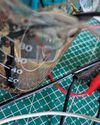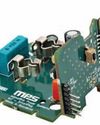eBEAM LITHOGRAPHY: A Breakthrough For Compound Semiconductor Fabrication
Electronics For You
|February 2025
eBeam technology catalyses innovation across industries, from driving efficient EVs to advancing quantum computing. Its integration marks a transformative leap in precision manufacturing.
Innovation propels electronics forward, meeting the growing demand for faster, smaller, and energy-efficient devices. Compound semiconductors—like gallium arsenide (GaAs), gallium nitride (GaN), and silicon carbide (SiC)—are powering advancements in 5G, electric vehicles, renewable energy, and optoelectronics.
Unlocking their full potential, however, requires evolving manufacturing processes. Electron beam (eBeam) technology, a precision-driven solution, promises to transform compound semiconductor production.
Why compound semiconductors?
Compound semiconductors differ from traditional silicon-based semiconductors because they handle high frequencies, high power, and optoelectronic applications with exceptional efficiency. These materials are critical for cutting-edge technologies, including:
5G networks. Supporting high-frequency transistors and RF components that are essential for faster data transmission
Electric vehicles. Enabling efficient power devices for inverters, chargers, and other components
Renewable energy. Powering high-efficiency energy conversion systems, such as solar inverters and wind turbines
Optoelectronics. Driving advancements in lasers, LEDs, and photodetectors for modern communication and sensing applications
Despite their impressive capabilities, manufacturing compound semiconductors presents unique challenges. Their distinctive properties and lower production volumes make traditional photolithography—a mask-dependent process—less effective and more expensive. This is where eBeam technology stands out as a transformative solution.
What is eBeam technology?
Bu hikaye Electronics For You dergisinin February 2025 baskısından alınmıştır.
Binlerce özenle seçilmiş premium hikayeye ve 9.000'den fazla dergi ve gazeteye erişmek için Magzter GOLD'a abone olun.
Zaten abone misiniz? Oturum aç
Electronics For You'den DAHA FAZLA HİKAYE

Electronics For You
Tech Majors Are Racing TOWARDS NET-ZERO - What About You?
Apple, Microsoft, Amazon, Google, Infosys, Wipro—global and Indian firms are heading closer to achieving net-zero emissions, a mandate to combat climate change. Here is what you need to know to start your journey...
12 mins
December 2025

Electronics For You
Miniature IoT WATER TDS And LEVEL MONITOR Cum CONTROLLER
For setups that rely on stored water, clear awareness of tank level and water quality is essential.
3 mins
December 2025

Electronics For You
The Impact Of GENERATIVE AI On The Future Of AUTOMOTIVE AND EVs
Autonomous vehicles, connected ecosystems, and smart factories are only the beginning. Generative Al is pushing the auto industry beyond predictions into a bold era of creativity-from EV design to real-time diagnostics and showroom automation. Here is how GenAl is reshaping innovation across the automotive value chain.
8 mins
December 2025

Electronics For You
How AI Tools Are Making SOFTWARE DEVELOPMENT BETTER
AI is reshaping how we code, debug, and collaborate. From Copilot to automation, it is changing software development in ways worth exploring.
3 mins
December 2025
Electronics For You
How AI Tools Are Making SOFTWARE DEVELOPMENT BETTER
AI is reshaping how we code, debug, and collaborate. From Copilot to automation, it is changing software development in ways worth exploring.
3 mins
December 2025

Electronics For You
5 Interesting Reference Designs FOR SMART HOMES
Smart home devices are transforming the way people interact with their appliances. They make homes more convenient, secure, and energy-efficient. From smart plugs and energy monitors to smart locks and thermostats, reference designs help design engineers create connected products that are easy to use, consume less power, and are reliable. These designs allow you to control devices remotely, track energy use, extend battery life, and automate routines. They provide practical solutions for upgrading homes and small commercial spaces without major modifications.
3 mins
December 2025

Electronics For You
Fancy USB LED VASE
This USB LED vase is a simple yet elegant device that fuses art with electronics to create a decorative lighting display. Powered directly from a standard USB port, it uses readily available components such as MOSFETs, resistors, capacitors, and LEDs to produce a striking, dynamic sequence of lights.
3 mins
December 2025

Electronics For You
"WHAT OTHERS SELL IN FOUR BOXES WE BUILT IN ONE"
Years of custom field work are shaping a product line with its own cloud, its own hardware, and a market that is now beginning to recognise its value.
8 mins
December 2025

Electronics For You
BUILD LARGE LANGUAGE MODELS
Large language models are machine learning models designed for a range of language-related tasks such as text generation and translation. Here’s how open source software can help you build your own large language model.
6 mins
December 2025

Electronics For You
Rare Earth Or Rare Ingenuity? India Remains Between The Two
With China firmly controlling rare earth exports, India confronts a critical moment in its technological trajectory.
8 mins
December 2025
Listen
Translate
Change font size

